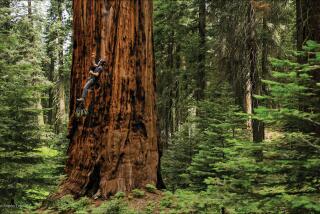Environmentalists, Vintners Face Off in Napa Valley
ST. HELENA, Calif. â To the 5 million tourists who visit Napa Valley each year, the quiet community offers an idyllic escape to a place where the wealth and the wine are always flowing.
But behind the picturesque charm of this viticultural Mecca brews an ongoing battle between vintners and environmentalists over the narrow stretch of land, 40 miles north of San Francisco, that has the wine industry looking for ways to stave off increased government regulation.
The Wine Institute and the California Assn. of Winegrape Growers recently released the industryâs first set of statewide environmental standards, including a 490-page workbook that offers vintners and growers guidelines on natural resource conservation, ecosystems management and employment practices.
âThe wine industry is one of the most regulated industries in America and whenever thereâs a problem, thereâs always a tendency to impose laws,â said Dennis Groth, chairman of the San Francisco-based Wine Institute, which represents more than 600 wineries producing 92% of California wine. âWe would like to think we donât need government telling us how to farm.â
But as Napa Valleyâs wine industry has soared to new heights in the last decade, local environmental activists say too many bottom line-driven companies have used unlimited farming methods that pollute the land, drain natural resources and kill wildlife.
âThere is a small sector among the vintners whose projects have been most controversial, but it is pervasive in that people want to do what they want with their land there,â said James Conaway, who has written two books chronicling the rise of the Napa wine industry and its bitter conflict with environmentalists.
In his new book, âThe Far Side of Eden,â Conaway indicts the wave of new-money millionaires from Silicon Valley, who have brought with them gaudy displays of wealth -- building so-called âMcMansionsâ and planting âvanity vineyardsâ -- and little agricultural integrity.
Their presence has created a backlash, as Napa County residents have passed dozens of local ordinances and environmental groups have filed lawsuits to preserve the areaâs natural beauty.
Among the biggest environmental issues in Napa has been soil erosion and watershed contamination caused by increased hillside development. Napa County has since enacted an ordinance requiring county approval of vineyards on slopes of 5 degrees or more.
The local government has also acted to enforce urban limit lines and create watershed task forces.
Napa County has had good ordinances but hasnât enforced them well, Conaway said.
The local Sierra Club sued the county in 2000, calling for stronger implementation of the hillside ordinance, and it has another suit pending to protect the wetland habitat of vernal shrimp from development by Beringer Blass Wine Estates.
âNapaâs a microcosm of whatâs going on statewide,â said Chris Malan, political co-chairwoman of the Redwood chapter of the Sierra Club, which filed the lawsuits.
Similar issues with vineyard development have sprung up around the state, including the Central Coast and Central Valley, although itâs been happening at an âexponential rateâ in Napa, Malan said.
In the Napa Valley, much of the development is driven by the high demand for Napa grapes and the scarcity of available agricultural land, said John DeLuca, Wine Institute president. Thatâs also led to changes in growing practices necessary to keep the area healthy for generations to come. California vintners want to keep the thriving industry in the state and not just become âthe international bottlers of other peopleâs juice,â he said.
The code earned the support of a number of government agencies and environmental groups, including the California Department of Food and Agriculture, the Nature Conservancy and the Environmental Protection Agency.
Robert Stephens, assistant secretary for environmental management and sustainability at the California EPA, said that the program is a âgood startâ and that his agency is planning to send the Wine Institute and grape growers a proposal to partner with them in its development.
âWe just want to encourage them to fully implement it to yield results,â Stephens said.
Members of the Sierra Club, however, have had a mixed reaction to the industryâs effort.
âI wouldnât say theyâre environmentally conscious,â Malan said. âI would say that they are waking up, and now they have to walk the walk.â
She added that there were still significant issues with habitat protection and chemical pesticide use that need to be addressed.
âThe industry is not embracing true sustainability until they move toward organic production,â Malan said.
But Tim Frank, legislative representative for the state chapter, said it would be a mistake to expect the code to solve every environmental problem. âThereâs a difference between ideal and a step moving in the right direction, and this is just a matter of the industry adopting a best practices guide that we would consider steps in right direction.â
More to Read
Sign up for Essential California
The most important California stories and recommendations in your inbox every morning.
You may occasionally receive promotional content from the Los Angeles Times.










